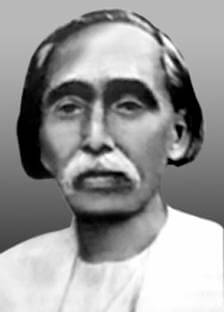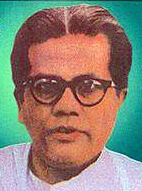Introduction
Padmanath Gohain Baruah is a name that holds immense significance in Assamese Literature and history. A man of extraordinary intellect and vision, he was not only a writer but also a poet, playwright, editor, and educationist. His contributions played a crucial role in shaping modern Assamese literature. His dedication to preserving and promoting the Assamese language set him apart as a true patriot and literary genius.
Early Life and Education
Born on October 24, 1871, in North Lakhimpur, Assam, Padmanath Gohain Baruah displayed brilliance from a young age. He studied in a Bengali medium school in Nakari when Assamese had been replaced by Bengali under British rule. After Assamese was reinstated in 1872, the lack of textbooks became a challenge. To address this, Padmanath and his friend Panindranath Gogoi took the initiative to write Assamese textbooks. After Panindranath’s untimely demise, Padmanath continued alone, producing books on history, geography, moral science, and physical exercise.
Contribution to Assamese Literature
Padmanath Gohain Baruah’s contributions to Assamese literature are remarkable. He was a multi-talented writer who excelled in various literary forms, including novels, poetry, plays, and essays. His works reflected his deep sense of nationalism and commitment to uplifting Assamese Culture.
The First Assamese Novelist
Padmanath Gohain Baruah holds the prestigious title of being the first Assamese novelist. His novel Lahori, published in 1892, is regarded as the first modern Assamese novel. While earlier attempts at novel-writing existed, Lahori stands out for its literary depth and structured storytelling. He later wrote Bhanumoti, a historical novel that was initially serialized in Bijulee, a popular Assamese magazine.
A Versatile Poet
His poetic prowess was evident in his works such as Lila Kabya, Jurani, and Phular Saneki. These poetry collections showcased his ability to weave emotions and depict Assamese culture beautifully through words. His poems were not just literary expressions but also carried deep philosophical and patriotic messages.
A Master Playwright
Padmanath Gohain Baruah’s contributions to Assamese theatre were groundbreaking. He wrote several historical, social, and mythological dramas that enriched Assamese drama and theatre.
- Joymoti, Gadadhar, Lachit Borphukan, and Sadhani – Historical plays depicting Assam’s glorious past and heroic figures.
- Ban Raja – A mythological drama based on the legendary love story of Usha and Aniruddha.
- Gaonburha – A social drama highlighting the economic struggles of Assamese people under British rule.
- Teton Tamuli and Bhoot Ne Bhram – Comedic plays that entertained audiences while subtly addressing societal issues.
His plays not only entertained but also educated people about Assamese history, making him an unparalleled figure in Assamese theatre.
A Crusader for Assamese Language and Literature
During his higher studies in Kolkata in the late 19th century, Padmanath Gohain Baruah became an active member of Asomiya Bhasar Unnati Sadhini Sabha, an organization formed by Assamese students to uplift Assamese language and literature. Despite not being able to complete his BA due to health issues, his time in Kolkata instilled a strong sense of nationalism in him. Upon returning to Assam, he dedicated himself to writing and language development.
Contributions to Assamese Journalism
Padmanath Gohain Baruah played a significant role in Assamese journalism. In 1901, along with Joydev Sarma, he launched Asom Banti, a weekly publication from Tezpur. At a time when Assamese literature was struggling to find a voice, Asom Banti became a powerful platform, addressing crucial issues and influencing public opinion. Later, in 1906, he started Usha, a monthly magazine that attracted contributions from notable literary figures like Hemchandra Goswami, Satyanath Bora, and Sarat Chandra Goswami. These publications not only enriched Assamese literature but also acted as catalysts for social change.
The First President of Asom Sahitya Sabha
In 1917, the Asom Sahitya Sabha was established as an organization to promote Assamese literature and culture. Padmanath Gohain Baruah had the honor of becoming its first president at the inaugural session held in Sivasagar. His leadership and vision played a crucial role in strengthening the organization and fostering literary growth in Assam.
His Lasting Legacy
Padmanath Gohain Baruah passed away on April 7, 1946, leaving behind an extraordinary literary legacy. His works continue to inspire and educate readers, keeping the spirit of Assamese literature alive. His life was a testament to his deep love for his mother tongue, and his contributions remain invaluable in shaping Assamese literary and cultural identity.
Notable Works of Padmanath Gohain Baruah
Poetry Collections:
- Juroni
- Lila Kabya
- Phular Saneki
Dramas:
- Gaonburha
- Joymoti
- Gadadhar
- Bhoot Ne Bhram
Novels:
- Lahori
- Bhanumoti
Conclusion
Padmanath Gohain Baruah was not just a writer but a revolutionary thinker who shaped Assamese literature, journalism, and education. His relentless efforts to uplift the Assamese language and his pioneering literary contributions make him one of Assam’s greatest literary figures. His legacy continues to influence generations of writers, making him an eternal icon in Assamese literature.
FAQ’s:
Q 1. Who was Padmanath Gohain Baruah?
Padmanath Gohain Baruah was a prominent Assamese writer, poet, and playwright. He played a key role in shaping modern Assamese literature and was the first president of the Asom Sahitya Sabha in 1917.
Q 2. Why is Padmanath Gohain Baruah important in Assamese literature?
He is considered the pioneer of the modern Assamese novel. His novel Lahori, published in 1892, is regarded as the first Assamese novel. He also contributed significantly to poetry, drama, and journalism.
Q 3. What were Padmanath Gohain Baruah’s major contributions to Assamese drama?
He wrote several historical and social dramas, including Joymoti, Gadadhar, Lachit Borphukan, and Sadhani. His plays highlighted Assam’s rich history and cultural heritage.
Q 4. How did Padmanath Gohain Baruah contribute to Assamese education?
He wrote multiple textbooks on history, geography, moral science, and physical education to support Assamese students and teachers. His work helped strengthen Assamese as a medium of instruction.
Q 5. What role did Padmanath Gohain Baruah play in Assamese journalism?
He co-published the weekly newspaper Asom Banti in 1901, which became a voice for Assamese language and literature. Later, he launched the magazine Usha, which featured writings from many literary figures.
Q 6. Where was Padmanath Gohain Baruah born, and where did he study?
He was born on October 24, 1871, in North Lakhimpur, Assam. He began his education in a Bengali medium school before moving to Kolkata for higher studies, where he actively promoted Assamese literature.
Q 7. What themes did Padmanath Gohain Baruah explore in his writings?
His works often focused on history, society, and mythology. His novel Bhanumoti was based on a historical theme, while Gaonburha depicted the struggles of Assamese people under British rule.
Q 8. How did Padmanath Gohain Baruah influence Assamese poetry?
He wrote several poetry collections, including Jurani, Lila Kabya, and Phular Saneki. His poems reflected deep emotions, patriotism, and the beauty of Assamese culture.
Q 9. What makes Lahori a significant novel in Assamese literature?
Lahori is considered the first modern Assamese novel because of its well-structured narrative and strong storytelling. It set the foundation for future Assamese novels.
Q 10. When did Padmanath Gohain Baruah pass away, and how is he remembered today?
He passed away on April 7, 1946. His contributions to Assamese literature and culture are still celebrated, and his works continue to inspire generations of writers and readers.












